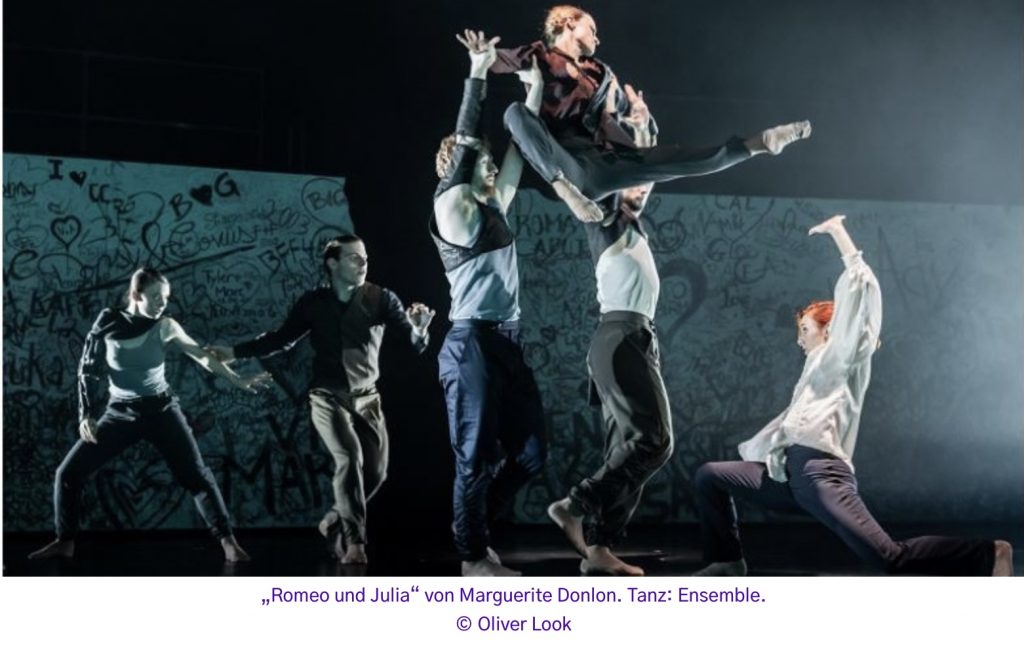ROMEO & JULIA
“Love is neither male nor female, but human. Marguerite Donlon choreographs wonderfully light and gender-neutral ‘Romeo and Juliet’.”
A coherent and thought-provoking choreography at the Theater Osnabrück.
HANNS BUTTERHOFOSNABRÜCK, 17/11/2022
“A woman in the role of Romeo in a ballet of ‘Romeo and Juliet,’ based on the classic love story by William Shakespeare, may seem strange at first glance. However, in her version of ‘Romeo and Juliet,’ premiered at the Theater am Domhof in Osnabrück, to the music of Sergei Prokofiev (1891 – 1953), Marguerite Donlon has remained true to Shakespeare’s tragic-comedy style. Shakespeare always presents the entire human life, which draws such an unclear line between male and female, much like between laughter and tears.
In the expected tragedy of the immortal lovers from Verona, Marguerite Donlon reliably captures the comedy, especially in the broad, space-filling ensemble scenes. With the Montague and Capulet families, costumed gender-neutrally by Belén Montoliú, Donlon choreographs their youthfulness with understanding. When one provocatively tugs on another’s jacket or chest-to-chest jumps in the air, it’s all adolescent showmanship, not to be taken too seriously. Or when the fighting roosters, carried by their buddies, fly towards each other like Kung-Fu fighters, the weightlessness of this performance takes away any seriousness from their fight, and it’s amusing due to its resemblance to cinematic tricks.
With gender-neutral casting, Donlon also achieves surprising psychological effects. When she casts the Capulet Tybalt, who murders Romeo’s friend Mercutio (Bojan Micev) from behind, with the delicate Marine Sanchez Egasse, it seems like a weakling trying to impress his comrades. Thus, the boys’ squabbles suddenly become deadly serious, particularly moving because the jester Mercutio continues to joke despite his injury, until he dies.
At the captivating wedding ball at the Capulets’, where Juliet (Ambre Twardowski) is to be introduced to Count Paris (Yi Yu), whom her stubborn family has chosen as her groom, gender neutrality becomes costume. The guests dance in a way that each person wears half a suit on one side and a doll with half a ball gown on the other, so that both their male and female aspects are apparent. The fact that these don’t always harmonize is demonstrated amusingly by a couple who even argue over who leads. Delightfully, in a similar inner conflict, Ajaka Kamei, Juliet’s ageless nurse, triumphs with curiosity about the letter’s secret.
The one-dimensional, disconnected characters like Juliet’s mother (Jeong Min Kim), who tries to force the traditional female role on her child and violently drags Juliet to the wedding ball, are drawn critically. In contrast, the groom Paris appears ridiculous, self-absorbed as he spins his pirouettes, oblivious to Juliet constantly evading his affected hand-kisses.
Ambre Twardowski as Juliet and Kesi Rose Olley Dorey as Romeo form a believable couple: For Donlon, they programmatically embody love in general, which is neither male nor female. Carried by the ensemble, Romeo and Juliet fly towards each other like a loving reflection of the combative Kung-Fu scene with floating lightness towards the kiss. They orbit each other and enjoy the shy touch of their hands and elbows. Perhaps they are drawn a bit too idealistically and obediently to completely shock in the more conventional solos towards their deadly end. However, Marguerite Donlon thus opens the view to the greater, general tragedy behind Romeo and Juliet’s fate: Neither their love nor their death ends their families’ enmity.

With her variable stage design, Belén Montoliú precisely comments on the state of the plot. At the beginning, the crack in a graffiti-covered wall indicates the conflict between the families, but it seems to close during the night of love. However, in the end, it stands wide open again. Beneath the surface of comedy lies the human tragedy of love and ongoing hatred, peace and war.
The Osnabrück Symphony Orchestra under Anhon Song accompanies and deepens the action with Sergei Prokofiev’s catchy, almost speaking music, thrillingly. After more than two captivating hours, it, like the enthusiastically dancing ensemble, receives bravo and long-standing applause from the enraptured audience for a coherent and thought-provoking choreography, despite all the entertaining comedy.”
The critic provides high praise for Marguerite Donlon’s choreography of “Romeo and Juliet” at the Theater Osnabrück. Donlon’s interpretation of Shakespeare’s classic tale features gender-neutral casting and remains faithful to the tragic-comedy style. Through skillful choreography, Donlon infuses moments of comedy within the expected tragedy, particularly evident in ensemble scenes depicting the youthful rivalry between the Montague and Capulet families. The use of gender-neutral costumes adds depth to character dynamics, while highlighting psychological nuances. Ambre Twardowski and Kesi Rose Olley Dorey deliver convincing performances as Juliet and Romeo, embodying love transcending gender boundaries. The staging, supported by the Osnabrück Symphony Orchestra’s evocative music, effectively conveys the underlying themes of love, hatred, and human tragedy. Overall, Donlon’s production receives acclaim for its thought-provoking narrative and entertaining execution.

BESETZUNG
Tanz und Co-Choreographie:
Julia: Ambre Twardowski
Romeo: Kesi Rose Olley Dorey
Mercutio: Bojan Micev
Benvolio: Richard Nagy
Amme: Ayaka Kamei
Tybalt: Marine Sanchez Egasse
Paris: Yi Yu Julias
Freundinnen: Emanuela Vurro, Valeria Schulz
Prinz von Verona: Esaúl Llopis
Mutter: Jeong Min Kim / Ayaka Kamei
Marine Sanchez Egasse, Valeria Schulz, Ambre Twardowski, Emanuela Vurro, Jeong Min Kim, Ayaka Kamei, Bojan Micev, John O’Gara, Yi Yu, Neven Del Canto, Richard Nagy, Esaúl Llopis Pater
Lorenzo: Oliver Meyer-Leive
Julia alt: Karin Brackhage / Dörthe Schmidt
Sprecherin: Hannah Walter
Osnabrücker Symphonieorchester
TEAM
Choreographie und Inszenierung: Marguerite Donlon
Musikalische Leitung: An-Hoon Song
Choreographische Assistenz, Co-Choreographie und Probenleiter: Francesco Vecchione
Komposition: Paul Calderone
Bühne und Kostüme: Belén Montoliú
Tanzrepitition: Wladimir Krasmann
Ausstattungsassistenz: Pauline Obermeyer
Inspizienz: Luisa Rubel, Anja Flemming
Bühnenmeister: Thomas Niemeyer
Licht: Ernst Schießl
Tanzmanagement: Britta Horwath
Ton: Jan von Triest
